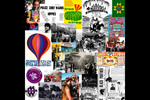|




| |
The Invisible Circus
February 24-26, 1967 / Sponsored by The Diggers, Artists Liberation Front, & Glide Church
Contents
The Invisible Circus was San Francisco's digger underground answer to both the Trips
Festival and the Human Be-In. The organizers (including members of the Artists
Liberation Front, the Diggers, and Glide personnel) staged this happening at Glide
Church, where the Artists Liberation Front had held one of the first Free Fairs the
previous fall.
Originally advertised as a "72 hour environmental community happening," the
event started Friday night and finally dissolved into the dawn's breaking light
on Sunday
morning. Nevertheless, the stories about those 36-plus hours became legend in San
Francisco's hip community for years.
Chester Anderson and Claude Hayward brought the Gestetner equipment that constituted
the free printing presses of the Communication Company, and set up shop in one of the
church offices. Richard Brautigan coined the name "John Dillinger Computer" for
the operation. From there, they issued bulletins and news flashes throughout the
night into the next day. The
resulting body of printed sheets comprises an instant archive of the event, of the free
space created within the walls of this liberated Tenderloin neighborhood sanctuary.
Chester was fond of telling about one such sheet, a story which typifies the
spontaneous nature of a digger event. He had taken a breather and went for a drink to a
bar across the street from Glide. There he overheard a heated discussion between two of
the bar's patrons. Chester, the ever-vigilant correspondent, whipped out his notepad and
jotted notes of this conversation. He then repaired to the Communication Company temporary
facilities and typed up his notes, ran off a few copies of this instant news bulletin, ran
back across the street and astounded these very patrons with copies of their conversation
memorialized in print.
Meanwhile, every cubicle of Glide was happening. The elevator to the basement opened to
a hallway filled with styrofoam. Wading through this fill was like a dream sequence of
being stuck in place while trying mightily to move. In another room, there was a panel
discussion on pornography. When it came time for the police vice squad officer to speak,
one of the diggers opened up a glass display case from its hidden access panel in the next
room, and laid his penis on the shelf. The audience broke apart in hilarity over the irony
of these two juxtaposed images, the staid cop discussing in a quite serious tone the
dangers of porn, while the anonymous flasher performed his silent interpretation of
"do your own thing" behind the podium. The cop never caught on to the
audience's guffaws.
I will try to put together a sampling of scanned instant news sheets from the Invisible
Circus. In the meantime, if anyone has stories from that event, feel free to add them to
the archive.
|
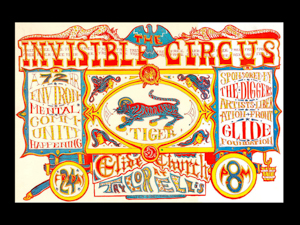
Dave Hodges poster (14-1/2" x 19-3/4")
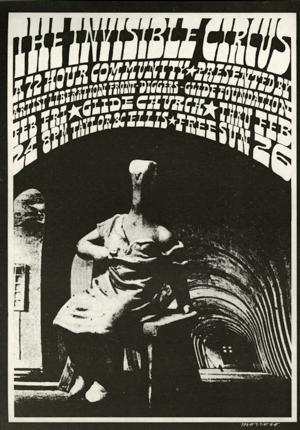
Victor Moscoso handbill (5-1/4" x 7-1/2")
|
<<==>>==<<==>>
|
The Invisible Circus & John
Dillinger Computer Instant News Service (Feb 24-26, 1967)
Presented by The Digger Archives at the Tenderloin
Museum, San Francisco, May 13, 2017
Note: click on images to view full-size graphic.
|
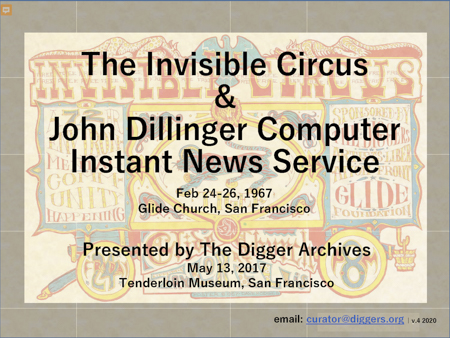 |
1. I’m going to talk about one of
the activities that took place at the Invisible Circus, an event at Glide
Church in 1967. Packed into 50+ rooms over three floors, 5,000 people (some
say 20,000) showed up that Friday night for what was billed a 72-hour
happening. In one of those rooms was a communication experiment that the
Communication Company collective had set up. Chester Anderson, Helene and
Claude Hayward, and Richard Brautigan along with dozens of volunteers,
called themselves the John Dillinger Computer. They were an instant news
service that, looking back 50 years, has a strong resemblance to what we
experience everyday in social media. This is the first occasion I have
presented the archive of materials here which I collected 40 years ago. |
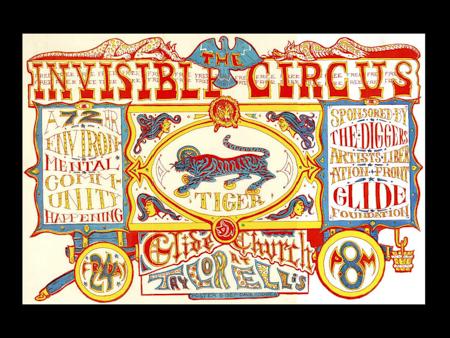 |
2. To understand what the intent
was behind the Invisible Circus, take a look at one aspect of this, the main
advertising vehicle for the event. It was drawn by Dave Hodges and printed
at the Bindweed Press, the same printer who produced the Family Dog and
Avalon posters. Notice that the names that appear on the poster are groups —
The Diggers, the Artists Liberation Front and Glide Foundation. Keep this in
mind as we look at the next slide. |
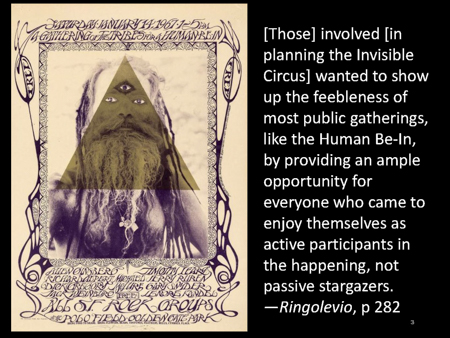 |
3. Here is the poster that had
announced the Human Be-In which took place in Golden Gate Park a month
before the Invisible Circus on Jan 14 1967. Notice that instead of groups,
there are names of individuals. The Human Be-In was an important milestone
in the emergence of the new bohemian-Beat community in the Haight-Ashbury.
But the format it took was criticized by the Diggers. Counterculture stars
like Allen Ginsberg, Timothy Leary and Gary Snyder spoke to the massive
crowd that filled the Polo Fields using microphones and loud speakers,
standing on a stage erected ten feet off the ground.
Here is a quote from Emmett Grogan who explained the motivation of the
artists and activists who planned the Invisible Circus: “[Those] involved
[in planning the Invisible Circus] wanted to show up the feebleness of most
public gatherings, like the Human Be-In, by providing an ample opportunity
for everyone who came to enjoy themselves as active participants in the
happening, not passive stargazers.” |
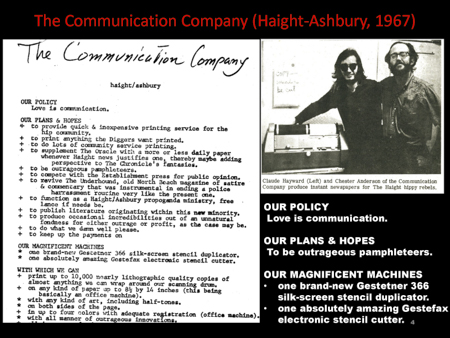 |
4. The ideology of the Diggers
was to create spaces for personal and collective autonomy. One of the groups
that took their inspiration from the Diggers was the Communication Company.
After hearing the Diggers rap about freedom, and what it meant in the midst
of an emerging new radical community, Chester Anderson and Claude Hayward
finagled the equipment to set up a printing operation in the Haight. Here is
their first publication, a broadside that announces their plans, one of
which was “to be outrageous pamphleteers.” Over the next several months,
from January to September 1967, the Communication Company printed 600 street
sheets that served as a channel of communication for the thousands of young
people who had made their way to the Haight-Ashbury. |
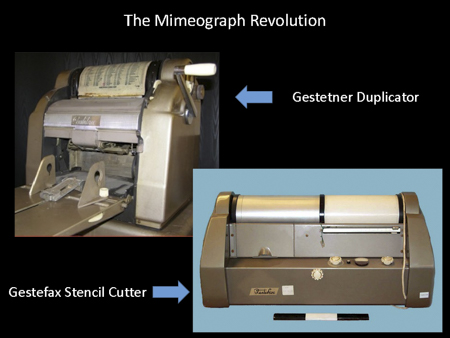 |
5. IN the coming decades,
cultural historians would identify the 1960s and 1970s as the blossoming of
the Mimeograph Revolution of small literary journals. But the mimeograph
revolution wasn’t limited to poetry. The Communication Company
broadsides were street literature and it wouldn’t have been possible without
the two pieces of equipment here. The top image is the Gestetner Duplicator
which was a highly advanced mimeograph machine. It used a silk-screen
process for printing its sheets. Thus, it was possible to print photographs
because the pixel size was small enough to resolve the image detail.
The bottom machine was a Gestefax Stencil Cutter, sort of like what we today
call image scanners. A sheet of paper that contained text and/or graphics
would be fixed to one drum of the Gestefax machine. On the other side, a
waxed stylus sheet would rotate and small holes punched into the stylus. The
stylus screen would then be run on the Gestetner duplicator mimeograph to
produce in some cases hundreds of copies. |
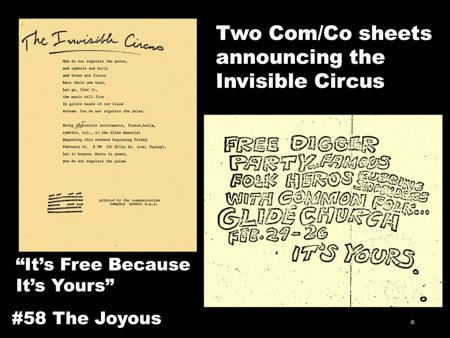 |
6. In the weeks leading up to the
Invisible Circus, the Communication Company published notices such as these
two. “Free Digger Party … Glide Church Feb 24-26 / It’s Yours.” That last
phrase came from a Digger expression, “It’s Free Because It’s Yours.”
The “Invisible Circus” poem reminds everyone that “You do not regulate the
pulse” and appends an I Ching hexagram for The Joyous with the judgment
“Success. Perseverance is favorable.” The Communication Company signed many
of their broadsides with I Ching hexagrams as a universal comment on the
particular instant. Here the poem invites the reader to “Bring percussion
instruments, flutes, bells, cymbals, etc. to the Glide Memorial Happening
this weekend beginning Friday February 24, 8 PM 330 Ellis St. (cor.
Taylor).” |
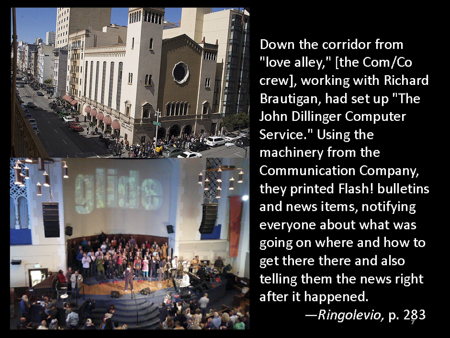 |
7. Claude and Helene and Chester
brought the Communication Company printing equipment to Glide Church and set
up in a backroom that Friday in February 1967. In Ringolevio, Emmett Grogan
described their operation:
From Ringolevio: Down the corridor from "love alley," [the Communication
Company crew], working with Richard Brautigan, had set up "The John
Dillinger Computer Service." Using the machinery from the Communication
Company, they printed Flash! bulletins and news items, notifying everyone
about what was going on where and how to get there and also telling them the
news right after it happened.“ (Ringolevio, p. 283) |
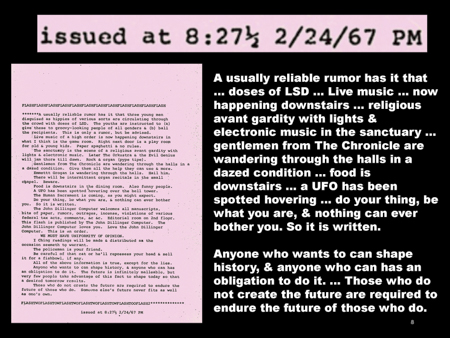 |
8. This is one of the first FLASH
bulletins that The John Dillinger Computer printed that evening. They relied
on volunteer roving reporters who would bring tidbits of information that
the editors put together into news Flashes all night.
This one was issued at “8:27-1/2 2/24/67 PM” The Communication Company was
often exact with dating on their broadsides, something of a rarity in street
literature.
This FLASH consisted of a set of messages much like individual telegrams or
notices. This format for a street sheet was common in the Com/Co and Digger
street sheets. A condensed version of the whole could be summarized by the
following brief synopsis:
A usually reliable rumor has it that … doses of LSD … Live music … now
happening downstairs … religious avant gardity with lights & electronic
music in the sanctuary … gentlemen from The Chronicle are wandering through
the halls in a dazed condition … food is downstairs … a UFO has been spotted
hovering … do your thing, be what you are, & nothing can ever bother you. So
it is written.
Another notice read, “The John Dillinger Computer welcomes all manuscripts,
bits of paper, rumors, outrages, incense, violations of various federal tax
acts, comments, &c &c. Editorial room on 2nd floor. … This flash is
published by The John Dillinger Computer. … I Ching readings will be made &
distributed as the occasion seemeth to warrant. … All of the above
information is true, except for the lies. / Anyone who wants to can shape
history, & anyone who can has an obligation to do it. The future is
infinitely malleable, but very few people take advantage of this fact to
shape today so that a desired tomorrow results. / Those who do not create
the future are required to endure the future of those who do. Someone else's
future never fits as well as one’s own.”
Through this semi-prophetic pronouncement we can see a prefiguration of the
coming information environment that personal computers and electronic
networks would bring. In that sense, the John Dillinger Computer was the
model of the future internet. It might not be too much an exaggeration to
suggest that Brautigan’s poem, “All Watched Over by Machines of Loving
Grace” which was handed out that night at the Invisible Circus, could be
viewed as a birth announcement for this coming world. |
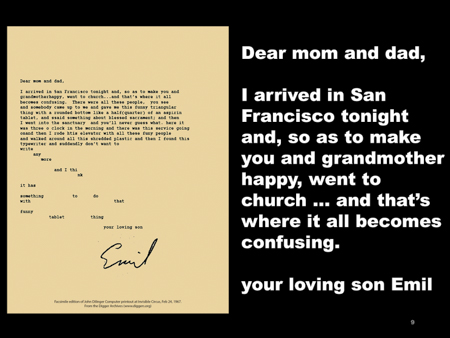 |
9. One of my favorite pieces is
this letter home supposedly from a young man who accidentally showed up at
Glide Church which Methodists would have been referred to on their arrival
in San Francisco. Upon entering the church, he became a participant in the
Invisible Circus. Whether this is a true story or a figment of someone’s
imagination, it became a prop in the theater of the absurd that was taking
place on five separate floors.
“Dear mom and dad,
“I arrived in San Francisco tonight and, so as to make you and
grandmotherhappy, went to church...and that’s where it all becomes
confusing. There were all these people, you see and somebody came up to me
and gave me this funny triangular thing with a rounded bottom like a
half (quarter) of an aspirin tablet, and ssaid something about blessed
sacrament; and then I went into the sanctuary and you’ll never guess what.
here it was three o clock in the morning and there was this service going
onand then I rode htis elevator with all these funy people and walked around
all this shredded plastic and then I found this typewriter and suddendly
don’t want to write
any more and I thi nk it has something to do with that funny tablet thing
your loving son” |
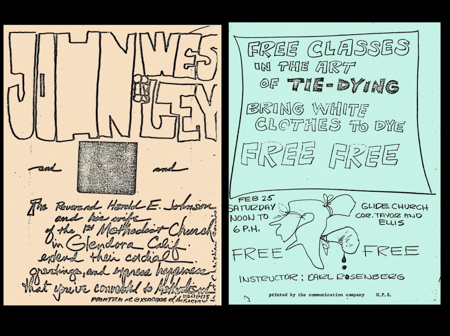 |
10. The Digger Archives has
approximately 80 sheets in the Invisible Circus collection. The following
screens show a sample of the sheets that I have scanned and restored. The
sheet on the right is for a tie-dye class on Saturday afternoon. The Digger
Free Store subsequently held classes which introduced the art of
tie-dye to the hippie counterculture. |
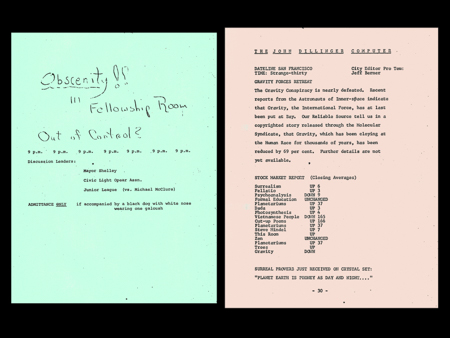 |
11. The sheet on the right was
produced by Jeff Berner who wrote occasional columns titled Astronaut of
Inner Space. Here under the title “Gravity Forces Retreat” we learn that
“Gravity which has been cloying at the Human Race for thousands of years,
has been reduced by 69 per cent. Further details are not yet available.”
|
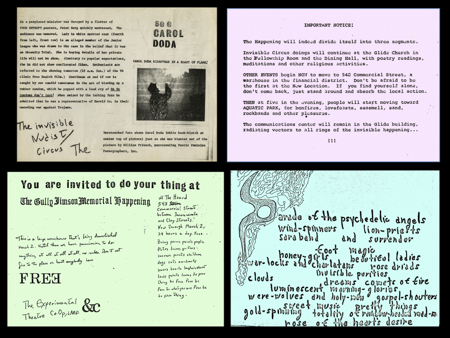 |
12. Notices of impending events
were quickly typed and distributed throughout the event. The “Important
Notice” in the top right sheet announces a dispersion of the event to three
different locations. The invitation in the lower left corner is for one of
those locations in the Financial District downtown. |
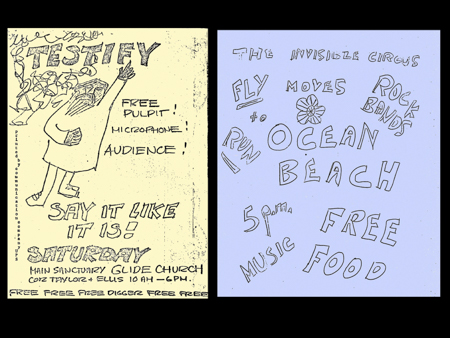 |
13. The blue sheet announces a
gathering at Ocean Beach for a sunset gathering. |
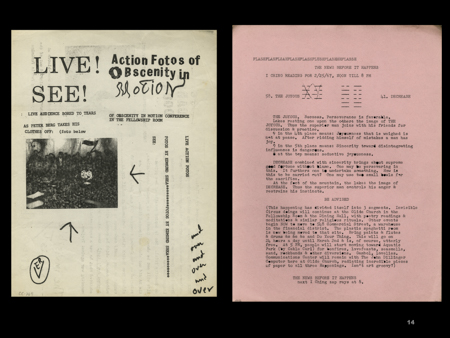 |
14. |
 |
15. Chester used I Ching readings
as comments that he appended to Com/Co editorials. But here are two Flash
bulletins that are I Ching readings in themselves. I Ching enthusiasts
believed that the synchronicity of the universe would provide insight into
the specific uniqueness of any moment. Chester termed these bulletins “The
News Before it Happened.”
In 1967 the most popular translation available of the ancient Taoist text
known in English as the Book of Changes was by Richard Wilhelm. Our commune
had a copy that we would reverently consult at moments of confusion and
important decisions. |
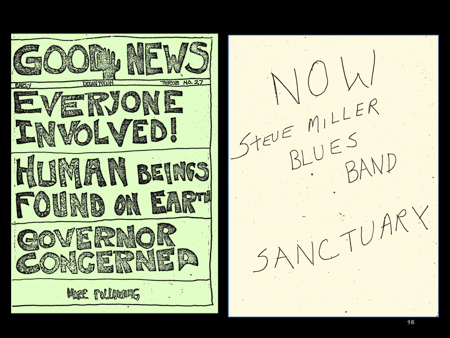 |
16. I have only restored and
scanned one-fourth of the collection. Most of the sheets here are
restorations of original scanned copies. The sheet colors are approximations
based on the notes I took when I Xeroxed the original set in 1972. |
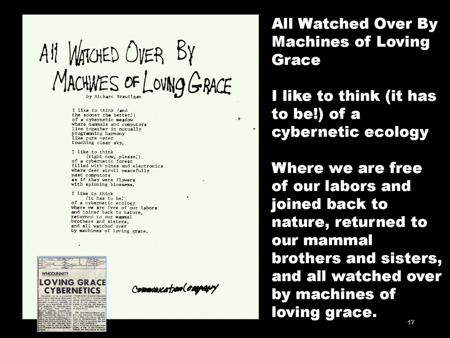 |
17. I had not looked at this
collection in many years, but in anticipation of the 50th anniversary of the
Invisible Circus, which happened this past February, I opened the archive
container and went through all the 80+ sheets in the John Dillinger Computer
collection. To my surprise this item was included, the first printing of a
poem by Richard Brautigan titled “All Watched Over by Machines of Loving
Grace” that read in part:
“I like to think (it has to be!) of a cybernetic ecology. Where we are free
of our labors and joined back to nature, returned to our mammal brothers and
sisters, and all watched over by machines of loving grace.”
This poem attained legendary status among technophiles in the San Francisco
Bay Area. For example, the first public computer network was designed and
setup in 1973 by the underground computer group known as Community Memory in
Berkeley. They adopted the name “Loving Grace Cybernetics” for their project
which would connect Berkeley and San Francisco counter-culturalists via
public terminals set up with free access (later paid) for anyone with
information to share or access. [Berkeley Barb, Aug 17 1973] A facsimile of
the original Community Memory kiosk at Leopold Records was on display at the
2017 Hippie Modernism exhibit at the Berkeley Art Museum and Pacific Film
Archive. |
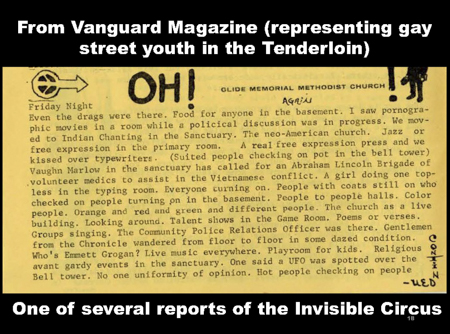 |
18. The Invisible Circus event
was open to anyone walking into Glide Church at the corner of Taylor and
Ellis streets in the middle of the Tenderloin neighborhood. Among the
attendees were representatives of Vanguard Magazine which was written and
published by Tenderloin gay street youth for whom Glide had been a
sanctuary. The church leadership had for years sponsored several of the
organizations that were early voices for the queer community. Here is a
report on the Invisible Circus written by one of the Vanguard writers. It is
one
of the best descriptions I’ve ever seen of a Digger event carried out under
the “create the condition you describe” rubric. |
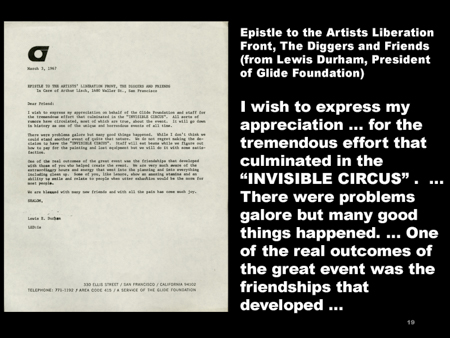 |
19. Here is a letter from the
president of Glide Foundation days after the Invisible Circus expressing
appreciation “for the tremendous effort.” The letter mentions that “There
were problems galore but many good things happened.” In my previous
presentation last year on the 50th anniversary of the founding of the
Diggers, I mentioned the outcome of the Invisible Circus on the life of the
minister of Glide Church, Cecil Williams. In his autobiography, Williams
describes the moment that he had a revelation at the Invisible Circus that
changed his outlook and his ministerial mission.
The letter from Glide was reprinted by Com/Co a couple weeks after the Invisible Circus and handed
out as a street sheet. |
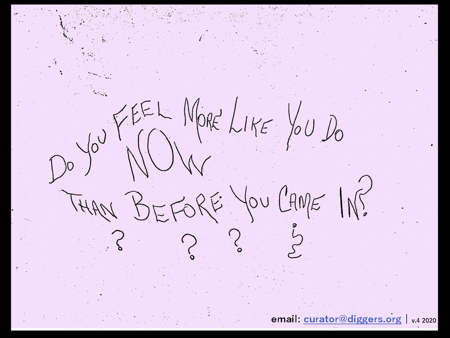 |
20. Singular moments of
revelatory import could be expected at any Digger event that was comprised
not of passive audience members but of “Life Actors” trying out roles for
living free. The anarchist theoretician Hakim Bey would term this event
model a “temporary autonomous zone.” There were likely many other singular
moments that took place that night — just as this street sheet produced at
the Invisible Circus asks, “Do you feel more like you do NOW than before you
came in???” Apart from individual revelations, Brautigan and the
Communication Company gang produced one of the more intriguing social
revelations of the night, The John Dillinger Computer, which represented an
information network model, a portent of the coming Internet and Web cyberculture.
—Eric Noble Bear
Rev. 4/24/2020 |
<<==>>==<<==>>
|
News Reports on The Invisible
Circus
|
| In his semi-autobiographical
account of the Sixties, Emmett Grogan wrote about two aspects of the
Invisible Circus which were not quite accurate. Emmett stated that Glide
(with the backing of the police) cut short the event barely eight hours
after it started. He also stated that no articles appeared in the press even
though local reporters had been on scene. Here's Emmett's account (Ringolevio,
p. 285):
"The press got wind of the goings-on at the Invisible Circus,
of course, and showed up with photographers and television news cameramen,
but no one would talk with them and they just hung around bug-eyed, ogling
the activity with their mouths gaping. The cops also came with several fire
marshals who brought court orders that ordered the building vacated
immediately because of an assortment of violated regulations which presented
fire dangers, such as the mountain of plastic in the basement. Needless to
say, the officials of Glide Church, who had been hovering on the brink of
cardiac arrest all night, were relieved by the court orders which were
announced throughout the building over the PA system and in bulletins handed
out by the John Dillinger Computer Service around 4 or 5 A.M. that Saturday
morning.
"During the eight or nine hours since it began, over
twenty thousand people had passed through the Invisible Circus and there's
no telling how many would have finally showed, if it had been permitted to
continue. When it was forced to end, the few thousand who remained went out
to the Pacific Ocean to herald the dawning of the sun, and to roast pork
sausages over a bonfire for breakfast, listening to Michael McClure play his
autoharp and sing his song, 'Oh, Lord, Won't You Buy Me a Mercedes Benz'
with Freewheelin' Frank singing, too, and beating on his tambourine. Even
though a dozen reporters spent nearly two hours at the church, not one line
was written nor one word spoken about the Invisible Circus in the news
media. It had been too incredible to explain, and so it and the fantasies
that were realized during its brief existence became personal memories
cherished by the people who were there and were part of an event, the likes
of which has never been seen again in the city of San Francisco."
|
 |
| I found two articles and one mention in the San Francisco Chronicle that dispute those
(admittedly, minor) assertions of Emmett's about the ending time and the
press coverage. The first mention appeared on that Friday, hours before the
festivities were set to begin. Ralph Gleason was the Chronicle's jazz
music critic who had published the first mention of the Diggers in the aboveground
press (in a column from the previous Fall). (Gleason even beat out the Berkeley Barb
which was the first underground newspaper to mention the Diggers.) In this
blurb from his column that day, Gleason wrote: The Glide Memorial
Foundation Church on Mason street, which is becoming sort of a downtown
annex of the Hashberry, is staging a 72-hour, non-stop event this weekend
beginning tonight at 7. Poets, musicians, painters, other artists, and
anyone who wants will participated. It's being called 'Invisible Circus —
The Right of Spring" and, in the words of some of its guiding spirits, poet
Richard Brautigan and artist Arthur Lish, [sic] it is not a happening but a
"complete environmental community" which will offer free food, publish its
own poems, newspaper and books. It is not directed at any one element in the
city. "All are invited to come and "occur." | The event will commence with
an invocation in the Sanctuary tonight by several poets. Big Brother and &
The Holding Company will sing and play "Amazing Grace"; at the 11 a.m.
regular Sunday services, Pig Pen of the Grateful Dead will play the organ in
the chapel, other rock bands will appear, Mouse, the artist who designs the
Avalon posters, will paint T-shirts. There will be belly dancers, formal
panel discussions, hopefully, with the police department on obscenity
in the arts. The Salvation Army band and the S.F. Narcotics squad have been
invited, the S.F. State Experimental College and the Berkeley Free
University. "It's a gigantic new energy force" its planners say. And it's
all free."
|
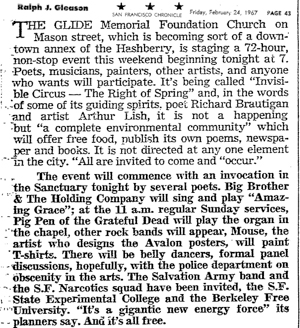 |
| Another article I found, and which directly
contradicts Emmett's assertion that there were no news accounts of the event
itself, is shown to the right. This appeared on Saturday, Feb. 25, 1967, in
The Chronicle, the morning after the opening of Glide's doors to "[a]
horde of hippies and their friends — replete with flowers, incense and good
things to eat..." The article mentions the event by name "something billed
as 'The Invisible Circus,' a monster happening put together by the Artists
Liberation Front..." The Diggers get a mention too, as providers of "food
and drink." A preview of coming attractions mentions "rooms will be
available where psychiatric social workers 'and housewives — why not — can
have dialogues.'" Claude Hayward is quoted in the article as the publisher
of the John Dillinger Computer, "an on-premises newspaper handed out by
little children every hour or so." The most memorable quote is from Claude
who described the event as "'a kind of anarcho-syndicalist thing." The
article must have been written before much had happened at the event. It
ends with this preview: "A group of dancers is scheduled to flit around the
church altar as lights flash on the screen while droppers-in sit in pews
holding sticks of incense." |
 |
|
The second article that I found
disputes both of Emmett's two points. (See image to right.) It appeared in the San Francisco
Chronicle on the Monday after the Invisible Circus. The article reports on a meeting
Sunday morning at Glide
between the top narcotics cop in San Francisco with a "group of hippies" who
had participated in what the Chronicle called a "gigantic happening" at the
church (without naming the Invisible Circus directly). Note the comments of
Rev. Mamiya who mentioned that there were 5,000 participants on Friday
night, and that "last night [Saturday] they all went down to the beach and
lit bonfires." That would dispute Emmett's statement that the event ended
Saturday morning. The article is interesting for several other points.
Chester Anderson is quoted as "Chisto Anderson ... who admitted being a
marijuana smoker for the past ten years" and who offered to take the police
lieutenant home and turn him on. The article mentions that there were "200
hippies, hippie watchers, church members, three Catholic nuns, two dogs and
a baby" in attendance at this Sunday morning crossfire and post-event
evaluation. Peter Cohon (aka Coyote) "claimed that the reason for the
upsurge in marijuana and LSD use was that a lot of fears of the harmful
effects of non-addicting drugs had disappeared." A visiting Catholic nun
from Kansas City had a positive view of the meetup — although she didn't
agree with "what they say," she offered that "they are very honest." It's
interesting that the Diggers were never mentioned in the second article, although
the Artists Liberation Front (as one of the sponsoring groups) was. At this
point in the Digger timeline, they were still trying to avoid press coverage
perhaps. That would change quickly in the coming weeks as the Diggers would
receive plenty of local (and underground) press coverage. |
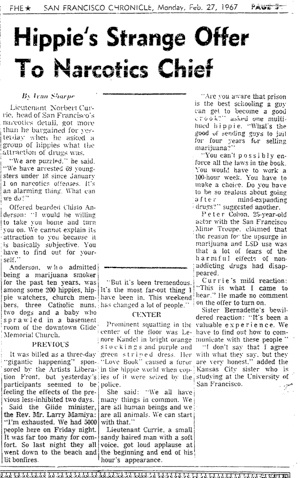 |
<<==>>==<<==>>
|
Gallery of Printed
Matter
[See separate page] |
<<==>>==<<==>>
|
Fuck the Church" epiphany
|
| This is a slide from a presentation I made on
the occasion of the 50th anniversary of the Diggers' Death of Money parade.
The slide shows the cover and a two-page spread from Cecil Williams' I'm
Alive autobiography.
Comment:
The next
morning the head minister, Cecil Williams, discovered graffiti that someone
had scrawled in the men's room. "Fuck the Church," it read. At first, Cecil
was outraged but then he experienced a religious epiphany. Here in his
autobiography he relates, "Fuck the Church. The church had been fucked by
the Invisible Circus. Fuck the Church and bring it life. Fuck the Church and
make it feel. Fuck the church until it becomes pregnant. Pregnant with a new
way of life." And from that moment, Cecil Williams felt an intense new
calling for Glide Church, which he began to preach in his sermon the next
day.
I'm Alive!: An Autobiography, by Cecil
Williams. San Francisco: Harper & Row, 1980, p. 97.
|
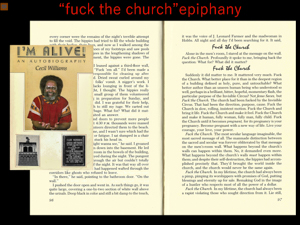 |
<<==>>==<<==>>
|
Other Accounts
|
<<==>>==<<==>>
|
Edits/Updates/Additions
[intro added 19961201, presentation section added 20200427, news
articles added 20200428]
|
|
|
|
|
